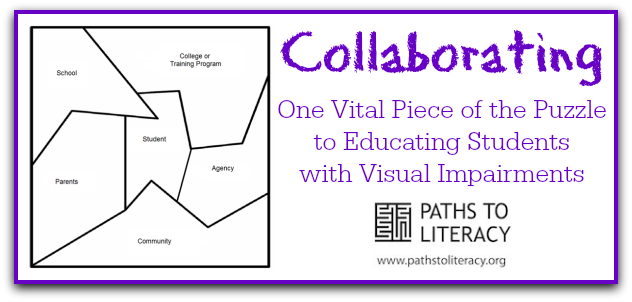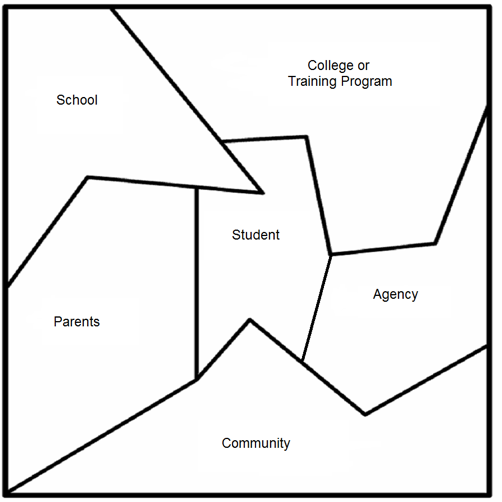Collaborating: One Vital Piece of the Puzzle in Educating Students with Visual Impairments
Submitted by Liz Eagan on Jun 23, 2015
According to Webster’s Dictionary, the word collaborate means “to work with another person or group in order to achieve or do something”. The student with a visual impairment has many needs that can be best met through collaborating amongst the educational team working with that student. As many of our students also receive assistance through outside agencies, it is important to be sure that parents have signed a consent to talk to the agency.
Collaboration can take many forms...from assisting with lesson planning to verbiage used when working with the student. This includes how the student generalizes the information taught at school, in the home or community environment, as well as what has been taught at home to children as they transition to the school environment. We must not forget what families have taught their child (i.e. appropriate behavior, manners).
To make collaborations successful, the team needs to listen to the other members and provide feedback to strategies, materials, and equipment that have been suggested or used by others. Collecting data can help with this. It can be vital to teach all members of the team the importance of data collection, as well how to collect it in a consistent way. I recommend making the data collection as simple as possible for team members, so that they are more likely to buy into doing it. Use the Instruction and Collaboration Plan document to keep track of what each team member promises to do and ensure that each team member keeps a copy of the document. I was given the document years ago and have no idea where it came from. I added to it over the years to make it more functional for my goals.
At the beginning of the school year, schedule a time to meet with the entire team. Decide as a group how frequently meetings are needed. Stress that any one team member can call a meeting of the team or part of the team when a need is present. Ensure that the parent is ALWAYS invited.
When working with outside agencies, consider the following:
Quick Tips for Successful Networking
- Introduce yourself as soon as you are aware of the agency representation
- Don’t wait for parents, agencies, etc. to come to you. Be proactive.
- Stay in touch with parents, agencies, etc. regularly.
- Always be specific about what your student's needs are.
- Know your own strengths.
- Network even when you think you don't need to.
- Learn what the agency provides in terms of support, materials, and trainings.
- Teach your student to be active in reaching out to agencies.
- Be helpful to others even if there's no obvious direct benefit to you.
- Don’t be afraid to ask for help.
- Keep your student’s goals in sight.
- Follow through quickly and efficiently on any action required of you.
- Focus on the long-term goals and not the short-term goals that may not be moving along as fast as you had hoped.
- Remember that networking is a two-way street.
- Develop patience. Rome wasn’t built overnight.
- Develop active listening skills
- Be organized. Keep track of meetings, phone calls, action items, etc.
- Remember the goal of all networking: your student
- Don’t be afraid to ask questions.
- Remember: the agency representative is not the enemy. They want to help the child just as much as you do.
Communication is VITAL to successful collaborations. Communication is defined by Merriam-Webster’s Collegiate Dictionary as “the exchange of thoughts, messages, or information, as speech, signals, writing or behavior.” In this exchange, both parties, the speaker and the listener, are partners. As partners they must both actively speak with a purpose in mind and listen attentively. Many times the message gets muddled due to our body language, ineffective listening skills, and tone of voice. Consider the following:
-
Be sure you realize and understand cultural differences and how they affect communication.
- Don’t use educational/special education jargon or phrases with vague meanings. Be clear in what you say.
- Don’t “shoot the messenger” who brings bad news unless you don’t want any more messages.
- Check frequently to see if all parties involved in the student’s educational and transitional planning are getting the information they need and want.
- Make sure when you communicate that you listen as well as talk.
- Be open to new mediums of communication such as newsletters, video reports, audio cassettes or regular e-mail updates.
- Use email to keep team members informed (even handwritten notices are good).
- Write letters of praise to members of the team about specific contributions.
- Spend more time with the team during stressful times, such as major projects, progress reports and ARDs (IEP meetings).
- Ask yourself each day if you have taken the time to listen to and understand the team members’ needs and concerns.
- Pay close attention to the nonverbal cues of the person or group you are working with.
Before starting your collaborations, consider what your goals are. For me, my goal collaborations is to bring all individuals (this includes parents and agencies) of the students educational team together in positive atmosphere of support to systematically plan as well as solve existing and emerging problems that could impact the student’s success. In conclusion, collaborations should focus on increasing student independence, success in the classroom, positive communications, and all while preparing the student for a successful and independent future.




Comments
I like this!